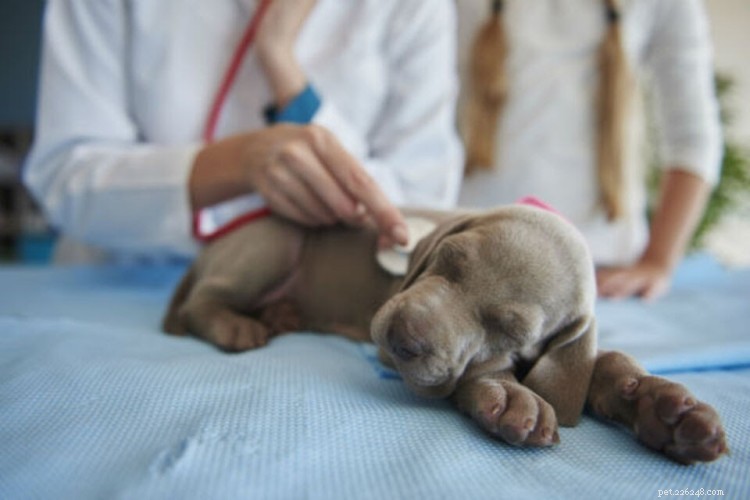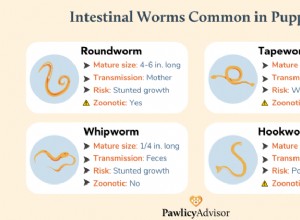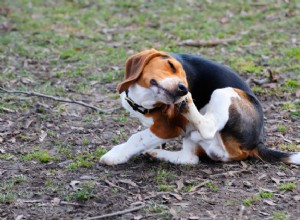
子犬は免疫システムが完全に発達していないため、多くの病気にかかりやすくなっています。 1 つの例は、腸を攻撃して重度の下痢、嘔吐、脱水症状を引き起こす厄介なウイルス、パルボです。パルボは非常に伝染性が高く、予防接種を受けていない生後 6 か月未満の子犬にとっては特に危険です。
このガイドでは、最も一般的なパルボの症状や、致命的な可能性のあるこの病気からペットを守るための手順など、子犬のパルボについて知っておくべきことをすべて説明します.
プロのヒント :子犬がすべての定期予防接種を受けていれば、ペット保険がパルボに適用されます。子犬が健康上の合併症を発症する前に登録することをお勧めします。そうしないと、その状態が補償されない可能性があります.
目次:
パルボまたは CPV として知られるイヌ パルボ ウイルスは、子犬や若い犬の胃腸 (GI) 系を攻撃する伝染性の高いウイルスです .ウイルスは、感染した子犬との接触や、水入れ、おもちゃ、さらには人間の手など、汚染された物体との間接的な接触によって簡単に広がる可能性があります.
ウイルスは胃と小腸を攻撃し、細胞を破壊し、栄養素の吸収を損ない、腸のバリアを破壊します。子犬では、パルボはリンパ球生成組織と骨髄にも影響を与える可能性があります.場合によっては、パルボウイルスが心筋 (心臓 CPV) に感染することがあります。 )、これは通常致命的ですが、あまり一般的ではありません。
ウイルスは耐寒性と耐熱性があり、屋外で最長 1 年間、屋内で最長 5 年間生存できます。 CPV はアルコール、洗剤、および多くの消毒剤に耐性があるため、封じ込めが難しい場合があります。
 (画像提供元:American Kennel Club)
(画像提供元:American Kennel Club)
子犬は、感染した糞便の匂いを嗅いだり、舐めたり、触ったりするたびにパルボにさらされます。これは、五感で世界を探索する若い犬にとって特に問題になる可能性があります.子犬のパルボ感染は、環境内で汚染された物体や人に接触するたびに発生する可能性があります.感染した糞便を踏んだ靴でさえ、ウイルスを家の中に持ち込むことができ、そのウイルスは土の中で最大 1 年間生きることができます。
すべての犬が危険にさらされていますが、ワクチンを接種していない生後 6 か月から 12 か月の子犬に最もよく見られます。 .幸いなことに、生後 6 週間未満の子犬は、母親がワクチンの全コースを受けていれば、母親の抗体の一部を保持しています。ペットの親は、特定の品種がパルボに感染するリスクが高いことに注意する必要があります:
これらの品種に属する子犬をパルボから保護するために、特別な予防措置を講じてください。
パルボに感染した子犬は、曝露から 4 ~ 5 日以内に、通常は臨床症状が現れる前にウイルスを排出し始めます。病気が始まると、子犬の最も一般的なパルボの症状には次のようなものがあります:
上記の危険信号のいずれかに気付いた場合は、できるだけ早く獣医に連絡してください .スタッフがさらなる伝染を防ぐために必要な検疫措置を講じられるように、子犬の状態とあなたの懸念を事前に伝えてください。
First, your veterinarian will run blood tests to confirm your puppy has parvo. The vet might also run an ELISA test to look for CPV antigens in the feces.
Parvo weakens a puppy’s immune system, lowers the white blood cell count, and damages the intestinal wall, reducing the pet’s ability to combat secondary bacterial infections. The mortality rate in canines that receive no treatment is over 90%, compared to 10-25% in those that are hospitalized . Therefore, hospitalization is strongly recommended for puppies with parvo symptoms.
Hospitalizing a puppy for parvo treatment costs about $2,000 to $3,000 just for the first day . Some patients might have to stay in the hospital for three to five days depending on the severity of the case (very sick puppies might stay in the hospital for up to ten days if they require intensive care).
Puppies infected with parvo will be placed in an isolation ward to prevent transmission between doctors, nurses, or other animals in the hospital. They will also receive IV fluids, pain medication, anti-nausea medication, and antibiotics. A nasogastric tube might also be necessary in order to provide nutritional support.
If hospitalization is not possible due to financial reasons, there’s an outpatient protocol that includes learning how to administer anti-nausea medication and IV fluids under the puppy’s skin, administering oral medications, and checking their temperature. Frequent vet visits will be necessary to check blood sugar levels and electrolytes on a daily basis. This option may not be possible depending on the severity of the infection.
Your vet will recommend an appropriate treatment for your puppy’s individual case and let you know which precautionary measures you should take in order to protect any other dogs and puppies in your home.
Pro tip :Treatment for parvo can require 10 days of hospitalization. Without pet insurance that could cost hundreds or even thousands of dollars. Luckily, routine puppy vaccinations, which can be covered through pet insurance plans, include vaccinations for parvo. These vaccinations require multiple shots and vet visits, so pet parents should take some time to compare pet insurance plans and find a policy that will cover this routine care.
 (Image source:PDSA)
(Image source:PDSA)
Most parvo patients recover if aggressive treatment is used and therapy is started before severe dehydration and septicemia occur. Most puppies that make it through the first three to four days will recover completely. Recovery usually takes about a week, but it depends on the severity of the case.
Some breeds, such as the Doberman Pinscher, English Springer Spaniel, and Rottweiler, have a significantly higher fatality rate than other dog breeds.
Puppies continue to shed the parvovirus for up to ten days after recovery, so make sure to keep any animals recovering from the virus away from unvaccinated or partially vaccinated dogs.
Parvovirus is preventable through vaccination . Puppies shoulbe be vaccinated against the virus every two to four weeks starting at six to eight weeks old, up until they are at least 16 weeks old. The last shot at 16 weeks is required for coonfidence in lasting immunity. Until the round of vaccines is complete, they should be kept away from public areas where other unvaccinated dogs could be, such as dog parks.
Ensure that all dogs in your home are vaccinated. It’s very important that female dogs receive a full series of parvo vaccines, as the young puppies depend on the dam’s antibodies in their first weeks of life. Pregnant females can also be boosted with a parvovirus vaccine 2-4 weeks before giving birth in order to transfer higher levels of antibodies to the puppies. Your vet will help you make the final decision about a vaccination schedule that best fits your pet.
You should also be extra careful when socializing your pet. Until puppies have received all of their vaccines, they should be allowed to come into contact with unvaccinated dogs. Avoid dog parks as well as other places where canines gather and try to socialize your puppy in less public environments such as your home.
The stability of the parvovirus in the environment makes it very important to properly clean and disinfect contaminated kennels, crates, bedding, and other areas where infected canines are kept in order to keep the spread under control. A solution of 1 gallon of water and 1/2 cup of chlorine bleach will disinfect water and food bowls, as well as other contaminated items. Your vet can provide specific guidance on cleaning and disinfecting agents for your home.

子犬の世話には、毛づくろいや餌を与えるだけではありません。お子様の最適な健康状態を確保するために、定期的に愛犬の駆虫を受ける必要もあります。 腸内寄生虫がないことを確認します。 ペット保険で子犬を守る 一般的な子犬の寄生虫について学ぶ ワームは、子犬の病気の最も一般的な原因の 1 つです。 、注意すべき兆候を知り、子犬の駆虫スケジュールを確立することは非常に重要です.この投稿では、どの寄生虫が駆虫薬を必要とするのか、どのようなリスクがあるのか、子犬が健康で幸せに成長できるように駆虫スケジュールを開始する時期について説明します. 子犬の駆虫について知っておくべきことは次のとおりです。

同伴者がいつもより頭を掻いたり振ったりしている場合は、犬が耳ダニに感染している可能性があります。耳ダニは、重度のかゆみや不快感を引き起こす非常に一般的な寄生虫です。幸いなことに、これらの寄生虫は伝染性が高いですが、治療は比較的簡単です. 犬に耳ダニがいると思われる場合は、知っておく必要があるすべてのことと、それらを取り除くために必要な手順を次に示します. 目次: 犬の耳ダニとは? 犬はどのようにして耳ダニに感染しますか? 犬の耳ダニの症状は? 犬の耳ダニの診断方法 犬の耳ダニの治療法 犬の耳ダニを予防する方法 重要ポイント プロのヒント: ダニ、耳の感染症、およびその他の一般的な